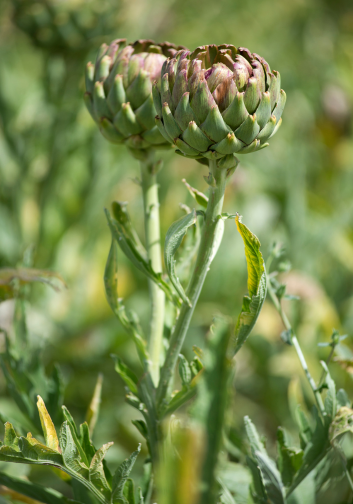Artichokes (Cynara cardunculus var. scolymus) are perennial thistles known for their edible flower buds before they come into bloom. They feature large, silvery-green leaves and can grow up to 3 to 4 feet tall and wide, making them not only a culinary delight but also a striking ornamental plant.

Artichokes are ready for harvest in their second growing season and can continue producing for 5 years or more. They thrive in mild climates but can be grown as annuals in colder regions. This guide will assist you in cultivating artichokes in your garden for both their aesthetic and edible benefits.
| Common Name | Artichoke |
| Botanical Name | Cynara cardunculus var. scolymus |
| Family | Asteraceae |
| Plant Type | Perennial (often grown as an annual in colder climates) |
| Size | 36 to 48 inches tall and wide |
| Sun Exposure | Full sun |
| Soil Type | Rich, well-drained |
| Soil pH | Neutral to slightly alkaline (6.5 to 7.5) |
| Bloom Time | Late summer |
| Hardiness Zones | 7-11, USDA (as a perennial) |

When to Plant?
For perennial growth, plant artichokes in the spring or fall. In colder climates where they are grown as annuals, start seeds indoors 8 weeks before the last frost date and transplant seedlings after the danger of frost has passed. Check our Frost Dates Across North America: First & Last Frost Dates Chart. However, the date will not be the same for every plant. Basil should be planted after the last spring frost. You can plant during the summer as well.
Companions
Good companions for artichokes include:
- Vegetables: Peas, cabbage, and sunflowers.
- Herbs: Tarragon and cilantro.
- Avoid: Planting artichokes near potatoes as they can compete for nutrients.
How to Plant
- Soil Preparation: Enrich the soil with compost and a balanced fertilizer. Artichokes require nutrient-rich soil for optimal growth.
- Planting Depth and Spacing: Plant seeds ¼ inch deep. Space seedlings or young plants about 2 to 3 feet apart to allow for their wide spread.
- Support: While generally not required, providing support can help maintain plant structure, especially in windy areas.

How to Cultivate
- Watering: Water regularly to keep the soil consistently moist but not waterlogged.
- Mulching: Apply organic mulch around the base to retain moisture and suppress weeds.
- Pest Management: Check for pests such as aphids and slugs. Use organic methods to control them.
How to Harvest
- Timing: Harvest artichokes in the spring of the second year when the flower buds are firm and before they begin to open.
- Method: Cut the bud off the stem with about 1-2 inches of stem attached.
- Perennial Care: After harvest, cut back spent plants to encourage new growth.
Hydroponics
- System Setup: Artichokes can be grown hydroponically but require a system that supports their large size, such as a deep water culture or Dutch bucket system.
- Nutrients: Provide a nutrient solution high in nitrogen and potassium to support leaf and bud growth.
Common Pests and Diseases
Artichoke Plume Moth
- Symptoms: Larvae tunnel into the buds and stems, causing damage.
- Management: Monitor plants and use organic pesticides if necessary.

Powdery Mildew

- Symptoms: White powdery spots on leaves and stems.
- Management: Ensure good air circulation; apply fungicidal sprays if needed.


